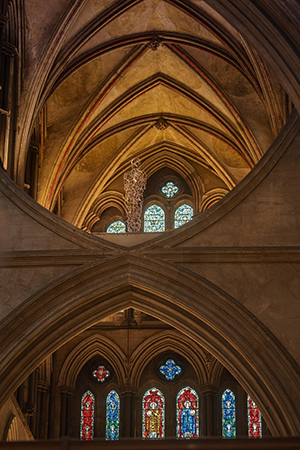The Reader and Homo Deus
We continue our virtual tour of the works in our Cathedral's exhibition.
Our present circumstances are raising all sorts of questions about what it means to be human and what we most value.
2 works in our exhibition relate closely to such questions.
The Reader is a 6-foot structure of a man (the artist) standing and reading a book. The artist’s website (www.stanza.co.uk) explains the work in a way which may resonate with our current experience of being bombarded daily with more information than we can take on board about COVID-19 :
"The Reader is a machine for the systems age. The Reader is a data visualisation sculpture about artificial intelligence and machine learning. Data is taking over our bodies... We live in a world of infobesity, we are bombarded with information... The data body acts to reposition a future view of ourselves when embedded technologies will become part of our everyday lives."
This may sound to us like material for a work of science fiction but there is much going on in technological research all over the world to suggest that it is not (cf 'Homo Sapiens and Homo Deus' by Yuval Noah Harari). So this work at once asks us to consider what we think it means to be a human being. Are we to think of ourselves as a flesh and blood computer, receiving, processing, storing and retrieving information? Or do we still feel that there is something more mysterious and perhaps only partly knowable about what it means to be human? Is there something unique about our humanity which gives us the power to interact with our environment and understand it, to communicate with one another, to make decisions, to lead purposive lives, to be creative? Is it this uniqueness which makes each one of us a body with a soul, or a spiritual body? And does the technological, materialist view of being human in the end reduce both our perception of the world and of ourselves?
Antony Gormley’s somewhat similar stainless-steel work, GRIP (NET) perched high above in the arch of the south choir aisle, by contrast, makes us deeply aware of our fragility and the questionable nature of our bodies. Gormley asks, "How do we treat the body not as a given, not as appearance, but as the place that we each find ourselves in?" At this moment we may know ourselves as bodies under severe restrictions on our movements, or bodies confined to the home. We may know that the Cathedral with its shallow foundations and the enormous weight of the spire, is itself a potentially fragile building, although it gives the impression of a solidity which no image of a human being could replicate. What does our fragility mean to us?
The purpose of much scientific research seems intended to make us less vulnerable to aging, natural weakness, disease, and disaster. Is it a human dream to become invulnerable or is there something about our fragility which makes the life we actually lead, rather than the life we might fantasise about, something deeply precious? Might it even be the case that all great art comes from this sense of fragility, our potential for suffering and loss, and our courage even so, to delight in creation and to create for ourselves? As Jeanette Winterson puts it in the recent catalogue for the Gormley exhibition at the Royal Academy, "Observing these bodies that are as unselfconscious as the natural world, and yet seem as knowing as the human world, we reflect on the maddening glory of our nature; so fragile and transitory, so stubborn and enduring." (Quotations are taken from the Royal Academy of the Arts Magazine Autumn 2019)
Read more here.
Credits: Jacquiline Cresswell, Curator, and Ash Mills, photographer.
Document Actions



